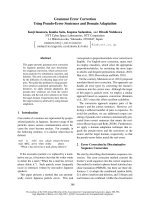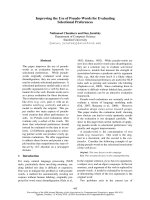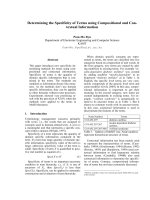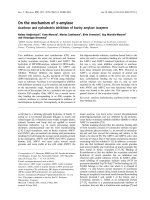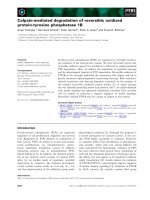Báo cáo khoa học: "Grammar Writing System(GRADE) of Mu-Machtne Translation Project and its Characteristic" docx
Bạn đang xem bản rút gọn của tài liệu. Xem và tải ngay bản đầy đủ của tài liệu tại đây (400.78 KB, 6 trang )
Grammar Writing System (GRADE) of Mu-Machtne Translation Project
and its Characteristics
Jun-tcht NAKAMURA. Jun-tcht TSUJII. Makoto NAGAO
Department of Electrical Engineering
Kyoto University
Sakyo. Kyoto. Japan
ABSTRACT
A powerful grammar writing system has been
developed. Thts grammar wrtttng system ts called
GRADE (GRAmmar DEscriber). GRADE allows a grammar
writer to write grammars Including analysts,
transfer, and generation using the same expression.
GRADE has powerful grammar writing facility. GRADE
allows a grammar writer to control the process of a
machine translation. GRADE also has a function to
use grammatical rules written tn a word dictionary.
GRADE has been used for more than a year as the
software of the machine translation project from
Japanese Into Engltsh. which ts supported by the
Japanese Government and called Nu-proJect.
1. Objectives
Vhen we develop a machine translation
system, the intention of a grammar writer should be
accurately stated tn the form of grammatical rules.
Otherwise, a good grammar system cannot be
achieved. A programming language to write a
grammar, which ts composed of a grammar writing
language, and a software system to execute tt. ts
necessary for the development of a machine
translation system (Bottet 82).
If a grammar writing language for a machine
translation system is to have a powerful writing
facility, tt must fulfill the following needs.
A grammar wrttlng language must be able to
manipulate linguistic characteristics tn Japanese
and other languages. The 11ngulstlc structure of
Jcpanese tS largely different from that of Engltsh,
for instance. Japanese does not restrict the word
order strongly, and allows the omission of some
syntactic components. Vhen a machine translation
system translates sentences between Japanese and
English, a grammar writer must be able to express
such characteristics.
A grammar writing language should have a
framework to write grammars tn analysis, transfer,
and generation phase using the same expression. It
Is undeslrable for the grammar writer to learn
several different expressions for different stages
of a machine translation.
There are many word specific linguistic
phenomena tn a natural language. A grammar writer
must be able to add word specific rules to a
machine translation system one after another to
deal wtth word specific linguistic phenomena, and
improve hts machine translation system over a long
period. Therefore. a grammar writing language must
be able to handle grammatical rules written tn word
dictionaries.
There ts a natural sequence tn a
translation process. For example, a parstng of
noun phrases which do not contain sententtal forms
is executed before a parsing of more complex noun
phrases. An approximate parsing of compound
sentences is executed before a parsing of complex
sentences. Also. when an application sequence of
grammatical rules are written explicitly, a grammar
writing system can execute the rules efficiently.
because the system Just needs to test the
applicability of a restricted number of grammatical
rules. So. a grammar writing language must be able
to express several phases of a translation process
in the expression explicitly.
A grammar writing language must be able to
treat the syntactic and semantic ambiguities tn
natural languages. But tt must have some
mechanisms to avoid a combinatorial explosion.
Keeping these points in mind, we developed
a new programming system, which ts composed of the
grammar writing language and its executing system.
Ve wtll call it GRADE (Grammar Describer).
2. Expression of the data for a processing
The form of data to express the structure
of a sentence during an analysis, a transfer, and a
generation process has a strong effect on the
framework of a grammar wrtttng language. GRADE
uses an annotated tree structure for expressing a
sentence. Grammatical rules tn GRADE are described
tn the form of tree-to-tree transformation wtth
annotation to each node.
338
The annotated tree tn GRADE ts a tree
structure whose nodes have ltsts of property names
and their values. Figure 1 shows an example of the
annotated tree.
~
-CAT - S~
-NUMBER - SINGULAI LE-NUMBER -
-SEM = HUMAN
E-CAT : Engllsh Category Symbol
E-NUMBER: English Number (SINGULAR or PLURAL)
E-SEM :Engltsh Semantic Marker
Ftgure 1 An example of the annotated tree tn GRADE
The annotated tree can express a lot of
Information such as syntactic category, number.
semantic marker, and other thtngs. The annotated
tree can also express a flag tn tts node. whlch ts
stmtlar to a flag tn a conventional programming
language, to control the process of a translation.
For example, in a grammar of a generation, a
grammatical rule ts applled to all nodes tn the
annotated tree, whose processtngs are not finished.
In such a case, a grammatical rule checks the DONE
flag whether ttts processed or not. end sets T to
the newly processed ones.
3. Rewriting Rule tn GRADE
The bastc component of a grammar wrtttng
language is a rewriting rule. The rewriting rule
In GRADE transforms one annotated tree tnto anoti~er
annotated tree. The rewriting rule can be used In
the grammars of analysts, transfer and generation
phase in a machtne translation system, because the
tree-to-tree transformation by thts rewriting rule
ts very powerful.
A rewriting rule tn GRADE conststs of a
declaration part and amatn part. The declaration
part has the following four components. (1)
Directory Entry part, whtch contains a grammar
writer's name, a verston number of the rewrttin 9
rule, and the last date of the revision. Thts part
ts not used at the execution ttme of the rewriting
rule. A grammar wrtter ts able to see the
information by ustng the help factltty of the GRADE
system. (2) Property Definition part, where a
grammar writer declares the property names and
thetr values. (3) Vartable Intt. part, where a
grammar wrtter declares the names of variables.
(4) Matchtng Instruction part, where a grammar
wrtter specifies the mode to apply the rewriting
rule to an annotated tree.
The matn pant specifies the transformation
tn the rewriting rule. and has the following three
parts. (1) Matchtng Condition part. where the
condition of a structure and the property values of
an annotated tree ts described. (2) Substructure
Operation part, whtch specifies operations for the
annotated tree that has matched wtth the condition
wrttten tn the matching condition pant. (3)
Creatton part, whtch spec|ftes the structure and
the property values of the transformed annotated
tree.
3.1. Matching Condition part
The matchtng condition part specifies the
condition of the structure and the property values
of the annotated tree. The matchtng condition part
allows a grammar writer to spectfy not only a rtgtd
structure of the annotated tree, but also
structures whtch may repeat several ttmes,
structures which may be omttted, and structures tn
which the order of thetn sub-structures ts not
restricted.
For example, the structure tn whtch
adjectives (ADJ) repeat arbitrary ttmes and a noun
(N) follows them tn Engllsh ts expressed as
follows.
ADJ ADJ N
>
matching_condition:
• (ADJS N):
AOJS: anyC~(ADJ)):
The structure 11ke a combination of a verb (V) and
an adverbial parttcle (ADVPART) tn thts sequence
wtth or without a pronoun (PRON) tn between tn
Engltsh tswrttten as follows.
V
(PRON) ADVPART
>
matching_condition:
• (V PRON ADVPART):
PRON: optional:
Atyptcal Japanese sententtal structure tn whtch
three adverbial phrases (ADVP). each composed of a
noun phrase (NP) and a case particle (GA, WO. or
NI) proceed an verb (V) tn no particular order ts
expressed as follows.
matching_condition;
~(A1 A2 A3 Y);
A1. A3: disorder;
ADVP1 ADVP2 ADVP3 V > Al: ~((ADVP1NP1GA)):
A A A A2:zCCADVP2 NP2 WO)):
NPl GA NP2 we NPa NZ A3: zCCAOVPa Ne3 .X)):
The matchtng condition part allows a
grammar wrtter to spectfy conditions about property
names and property values for the nodes of the
annotated tree. A grammar wrtter can compare not
only a property value of a node wttha constant
value, but also values between two nodes tn a tree.
339
For example, the number agreement between a subject
noun and a verb Is written as follows.
matching_condition:
~(NP
UP):
NP.NUNBER " VP.NUNBE~;
3.2. Substructure Operation part
The substructure operation part spec'tftes
operations for the annotated tree which has matched
wtth the matchtng condition part. The substructure
operation part allows a grammar writer to set a
property value to a node. and to assign a tree or a
property value to a variable, whtch is declared tn
the variable tntt. part. It also allows htm to
call a subgnammar, a subgnammar network, a
dictlonary rule. a bullt-ln functlon, and a LISP
function. The subgrammar, the subgramman network.
the dicttonany rule, and the butlt-tn function w111
be discussed tn sectton 4 5., and 6. In
addition, a grammar wntter can write a conditional
operation by using the IF-THEN-ELSE form. An
operaLion to set 'A' to the lextcal untt of the
determiner node (DET.LEX). tf the number of the NP
node |S SINGULAR. Is wrttten as follows.
substnuctune_operatton:
tf NP.NUMBER - 'SINGULAR':
then DET.LEX <- "A':
else DET.LEX <- "NIL';
end_tf:
Transformation of matn part tn a newntttng rule:
A A
/b,, I
B C O > E
/t,,,
B C D
Transformation of a whole annotated tree:
A A
ABCD > A E
/t,, I /b,,
BCD E BCD
/t,,,
BCD
Figure 2 An example of an application of the main
part
The matching tnstnuctton pant specifies the
travense path of the annotated tree. There are
four types of the traverse pathes, whtch are the
combinations of <left-to-right or night-to-left>
and <bottom-to-top on top-to-bottom>. When a
grammar writer specifies left-to-right and
bottom-to-top mode, the annotated tree w111 be
traversed as follows.
5
3 /
3.3. Creation part
The structure and the property values of
the transformed annotated tree ts written tn the
creation part. The transformed tree ts described
by node names such as NP and VP, whtch are used in
the matchtng condition part on the substructure
operation part. A cneatton part to create the tree
whose top node ts S and whtch has a NP sub-tree and
a VP sub-tree ts wnttten as follows.
creation:
Z((S NP
VP)):
3.4. Matching Instruction part
The maln part of a rewrltlng rule In GRADE
(the matching condition part, the substructure
operation part. and the creatlon part) can be
applied not only to a whole tree, but also to
sub-trees. Figure 2 shows an example of the
application of a maln part.
4. Control of the grammatical rule applications
A grammar writing language must be able to
express detailed phases of a translation process tn
the expression expltctt]y. GRADE allows a grammar
writer to divide a whole grammar into several
parts. Each part of the grammar ts called a
subgnammar. A subgrammar may correspond to a
grammatical unit such as the parstng of a stmple
noun phrase and the partng of a compound sentence.
A whole grammar ts then described by a network of
subgrammars. Thts network ts called a subgnammar
network. A subgrammar network allows a grammar
writer to control the process of a translation tn
detatl. When • subgrammar network tn the analysts
phase consists of a subgrammar for a noun-phrase
(SG1) and a subgrammar
for
a verb-phrase (SG2) tn
this sequence, the executor of GRADE first appltes
SG1 to an input sentence, then appltes SG2 to the
result of an application of SG1.
4.1. Subgrammar
A subgrammar conststs of a set of rewriting
rules. Rewriting rules tn a subgrammar have a
prtontty ondertng tn their application. The n-th
340
rewriting rule tn a subgrammar tstrted before the
(n+l)-th rule.
A grammar wrtter can spectfy four types of
application sequence of rewriting rules tn a
subgrammar. Let us assume the situation that a set
or rewriting rules tn the subgrammar ts composed of
RR1. RR2 and RRn. that RR1 and RR|-I
cannot be applied to an tnput tree. and that RRt
can be applted to tt. When a grammar wrtter
specifies the ftrst type. whtch ts called ORDER(I).
the effect of the subgrammar execution ts the
application of RRt to the tnput tree. When a
grammar wrtter specifies the second type. which |s
called ORDER(2). the executor of GRADE trtes to
apply RRt+I RRn to the result of the
application of RRt. So. ORDER(2) means that
rewriting rui~s tn the subgrammsr are sequentially
applted to an tnput tree.
The thtrd and fourth type. whtch are called
ORDER(3) and ORDER(4). are the Iteration type of
ORDER(l) end ORDER(2) respectively. So, the
executor of GRADE trtes to apply rewriting rules
untt1 no rewriting rule Is applicable to the
annotated tree.
SEARCH-CANDIDATE-OF-HOUNS.sg:
sg_mode: order(Z):
rr_tn_sg:
CANDIDATE-OF-NOUNS-t:
UP-NP-TO-PNP:
CANDIDATE-OF-NOUNS-Z;
end_sg.SEARCH-CANDIDATE-OF-NOUNS:
Ftgure 3 An example of a subgrammar
Ftgure 3 shows an example of a subgrammsr.
When thts subgrammar is applted to an annotated
tree. the executor of GRADE ftrst trtes to apply
the rewriting rule CANDIDATE-OF-NOUNS-1 to the
tnput tree. If the appl|catton of thts rule
succeeds, the tnput tree ts transformed to the
result of the application of the rewriting rule
CANDIDATE-OF-NOUNS-1. Otherwise. the tnput tree ts
not modified. In etther case. the executor of
GRADE next tr|es to apply the rewrtt|ng rule
UP-NP-TO-PNP to the tnput tree. The executor
continues such a process untt1 the application of
the last rewriting rule CANDIDATE-OF-NOUNS-2 ts
finished.
4.2. Subgramar Network
A subgrammar network descr|bes the
application sequence of subgrauars. The
specification of a subgrammar network conststs of
the following ftve parts. (1) Directory Entry
part. whtch ts as the same as the one tn a
rewriting rule. (2) Property Definition part.
whtch Is the same as the one tn a rewriting rule.
This part ts used as the default declaration tn
rewriting rules. (3) Vsrtable ]ntt. part. which ts
the same as the one tn a rewriting rule. The
variables are used to control the transition of the
subgrammar network. The variables are referred to
and asstgned tn the substructure operation part of
the rewriting rule. The variables are also
referred tne 11nk specification part. whtch wtll
be described later. (4) Entry part. whtch
specifies a start node of the network. (5) Network
part. whtch specifies a network of subgrammars,
The network part spec|f]es the network
structure of subgrammars, and conststs of node
specifications and 11nk spectftcat|ons. The node
specification has a label and a subgrammer or s
subgnammar network name. whlch ts called when the
node gets the control of the processing. The 11nk
specification specifies the transit|on among nodes
tn a subgramman network. The 11nk specification
checks the value of a verteble whtch |s set tn •
rewriting rule. and dectdes the label of a node
whtch wtll be processed next.
PRE.sgn;
directory_entry:
owner(J.NAKAHURA): verston(VO2L05):
last_update(83/12/25):
var_tntt;
OPRE-FLAG tntt(T):
entry:
START:
network:
START: PRE-STEP-|osg;
LOOP : PRE-STEP-2.sg;
A:
PRE-STEP-3.sg:
B:
PRE-END-CHECK.sg:
|f OPRE-FLAG: then goto LOOP:
else goto LAST:
LAST: PRE-STEP-4.s9:
extt:
end_sgn.PRE;
Ftgure 4 An example of a subgrammar network.
Ftgure 4 shows an example of a subgrammar
network. When the executor of GRADE appltes thts
subgranunar network to an tnput tree. the executor
checks the var-tntt part. then puts a new vartable
OPRE-FLAG on a stack, and sets T to OPRE-FLAG as an
tntttal value. After that. the executor checks the
entry part and find the label of the start node
START tn the network. Then the executor searches
the node START and applles the subgrammar
PRE-STEP-1 to the tnput tree. After the
application, the executor appltes the subgrammer
PRE-STEP-2 (node name: LOOP) and PRE-STEP-3 (node
name: A) to the annotated tree tn thts sequence.
Next. the executor applles the subgrammar
PRE-END-CHECK (node name: B) to the tree.
341
Rewriting rules in PRE-END-CHECK examine the tree
and set T or NIL to the variable ePRE-FLAG. The
executor checks the link spectf|catJon part, which
is started by IF. and examines the value of the
variable @PRE-FLAG. The node in the network which
will be activated next is the node LOOP if
@PRE-FLAG is not NZL, otherwlse, the node LAST.
Thus, while @FRE-FLAG ts not NIL, the executor
repeats the applications of three subgrammars,
PRE-STEP-2. PRE-STEP-3. and PRE-END-CHECK. to the
annotated tree. When @PRE-FLAG becomes NIL. the
subgrammar PRE-STEP-4 tn the node LAST ts applted
to the tree. and the application of thls subgrammar
network PRE Is terminated.
5. Handling the grannaatlcal rule tn the word
dictionaries
GRADE allows a grammar wrtter to write word
specific grammatical rules as a subgramman In an
entry of word dictionaries of a machine translation
system. A subgramman written in a dictionary entry
is called a dictionary rule. The dictionary rule
is specific to a particular word In the dictionary.
The dictionary rule is retrieved wttha
entry word and a rule identifier as the key. and is
applied to the annotated tree which is specified by
a grammar writer, when CALL-DIC operation In the
substructure operation part Is executed. Figure 5
shows an example of a rewriting rule which calls a
dictionary rule. In thts case. a dictionary rule
which ts written in an entry of a word as indicated
by V.LEX (the value of the lextcal untt of verb).
and whose name ts ANALYSIS. ts epplted to the
sequence of NP1. V. NP2. and PP (noun phrase 1.
verb phrase, noun phrase 2. and prepositional
phrase). Then the result of the application of the
dictionary
rule
Is assigned to the vartable
aS.
CASE-FRANE.rr:
var_tntt: aS;
matching_condition:
Z(NPZ v Me2
PP):
substructure_operation:
@S <- ca11-dtc(V.LEX
ANALYSIS Z(NP1V NP2
PP)):
creation:
~(es):
end_Pr.CASE-FRAME:
Ftgure S An example of a rewriting rule which calls
a dictionary rule
6. Treatment of Ambiguities
A grammar wrtttng language must be able to
treat the syntactic end semantic ambiguities in
natural languages. GRADE allows a grammar writer
to collect all the result of possible tree-to-tree
transformations by a subgrammar. However,
It
must
avoid a combinatorial explosion, when tt encounters
the ambiguities.
For instance, let us assume that a grammar
writer writes a subgramman which contains two
rewriting rules to analyze the case frame
of •
verb, that a rewriting rules ts the rule to
construct VP (verb phrase) from V and UP (a verb
and a noun phrase), and that the other ts the rule
to construct VP (verb phrase) from V. NP and PP (a
verb. a noun phrase, and a prepositional phrase).
When he specifies NONDETERMINISTIC_PARALLELED mode
to the subgremmar, the executor of GRADE 8ppltes
both rewriting rules to an Input tree, constructs
two transformed trees, and merges them tnto 8 new
tree whose top node has 8 spectal property PARA.
The top node of this structure is called a pare
special node. whose sub-trees are the transformed
trees by the rewriting rules. Figure 6 shows an
example of thts mode and apara node.
'7
V NP PP SG
PARA
VP PP VP
A A",,
V NP V
NP PP
Figure 6 An example of a pars speclal node
A grammar writer can select the most
appropriate one from the sub-trees under a pare
special node. A grammar
writer
ts able to use
built-in functlons. MAP-SG. MAP-SGN. SORT. CUT. and
INJECTION in the substructure operation part to
choose the most appnoprlate one. Figure 7 shows an
example to use these bullt-Jn functions.
substructure_operation:
eX <= ca11-dtc(V.LEX CASE-FRAME Z(N NP PP)):
eX <- ca11-butlt(map-sg ~(gX) tree
EVALUATE-CASE-FRAME):
@X <- call-built(sort Z(@X) tree SCORE):
@X <- cell-built(cut [(eX) tree 1):
9X <- call-built(Injection ~(eX) tree 1):
Figure 7 An example of bullt-ln functions
In this substructure operation part. the
executor of GRADE appltes the dictionary rule
wrttten tn a word which ts the value of V.LEX
(lexlcal untt of verb) to the tree. and sets the
result
to
the vartable eX. When the
nondetermtnisttc-paralleled mode ts used tn the
dictionary rule. the value of eX ts the tree whose
root node tsa pare spectel node. After that, the
executor calls butlt-tn functton MAP-SG to apply
342
the subgrammar EVALUATE-CASE-FRAME to each sub-tree
of the value of OK. and sets the result to eX
again. The subgrammar EVALUATE-CASE-FRAME computes
the evaluation score end sets the score to the
value of the property SCORE tn the root node of the
sub-trees. Next, the executor calls butlt-tn
functton SORT. CUT. and INJECTION to get the
sub-tree whose score Is the highest one among the
sub-trees under the pare spectal node. This tree
ts then set to 9X as the most appropriate result of
the dictionary ru]e.
The para spectal node ts treated as the
same as the other nodes tn the current
Implementation of GRADE. A grammar wrtter can use
the para node as he want, and can select a sub-tree
under a pare node at the later grammatical rule
application.
7. System configuration end the environment
The system configuration of GRADE ts Shown
tn Figure 8. Grammatical rules written tn GRADE
are first translated tnto tnternal forms, which are
expressed by s-expressions tn LISP. This
translation ts performed by GRADE translator. The
Internal forms of grammatical rules are applted to
an tnput tree. which ts an output of the
morphological analysts program. Thts rule
application Is performed by GRADE executor. The
result of rule applications |s sent to the
morphological generat4on program.
Dictionary Grammar
f
J GRADE
translator
1/ \
Dictionary Grammar
(Internal form)
rule ~ ~ r~
tnput_~ GRADE ~output
sententtal tree|executor J sententtal tree
Ftgure 8 The system configuration of GRADE
GRADE system ts mrttten tn UTILISP
(University of Tokyo Interactive LISP) and
Implemented on FACON M382 wtth the additional
functton of handllng Chatnese characters. The
system ts also usable on Ltsp Machtne Symbollcs
3600. The program stze of GRADE system ts about
10.000
ltnes.
the form of tree-to-tree transformation rtth
annotation to each node. (2) Rewriting rule has •
powerful wrtttng facility. (3) Grammar can be
divided Into several parts and can be 11nked
together as a subgrammar network. (4) Subgrammar
can be written tn the dictionary entrtes to express
word spectftc linguiStiC phenomena. (5) Spectel
node ts provtded tn a tree for embedding
ambiguities.
GRADE has been used for more than a year as
the software of the nattonal machtne translation
project from Japanese Into English. The
effectiveness of GRADE has been demonstrated tn
thts project. The linguistic parts of the project
such as the morphological analysts/generation
programs, the grammars for the analysts of
Japanese. the transfer from Japanese Into Engltsh
and the generation of Engllsh. are discussed tn
other papers (Sakamoto 84) (TsuJt1 84) (Raged 84).
Thts study: "Research on the machtne
translation system (Japanese-English) of scientific
and technological documents" Is betng performed
through Spectal Coordination Funds for Promoting
Science & Technology of the Science and Technology
Agency of the Japanese Government.
ACKNOWLEDGEMENTS
Ve would 11ke to acknowlege the
contribution of N. Kogt. F. Ntshtno. Y. Sakane. M.
Kobayasht. S. Sate. and Y. Senda. who programmed
much of the system. We mould also 11ke to thank
the other member of Me-project for their useful
comments.
REFERENCES
Bottet. Ch., et el. Implementation and
Conversational Environment of ARIANE 78.4. Proc.
COLING82.
1982.
RageD, M., et el, Dealtng wtth Incompleteness of
Linguistic Kno~ledego on Language Translation.
Proc. COLING84o ;964.
Sakamoto, Y et al, Lextcon Features for Japanese
Syntactic Analysts In Mu-ProJect-JE, Proc.
COLING84, 1984.
TsuJtt, J., et el, Analysts Grammar or Japanese tn
Hu-ProJect, Proc. COLING84, ;984.
8. Conclusion
The grammar wrtttng system GRADE ts
discussed 4n thts paper. GRADE has the follow4ng
featureS. (I) Rewriting rule ts an expression tn
343

